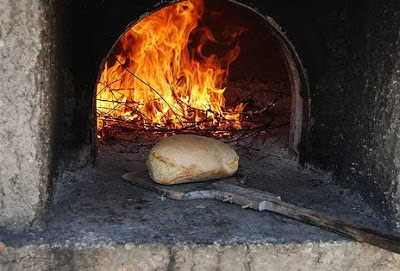Crete, the largest of the Greek islands, is renowned for its rich culinary traditions, which are deeply rooted in its history and culture. Among the many culinary practices that have been passed down through generations, the use of traditional bread ovens stands out as a symbol of the island’s gastronomic heritage. These ovens, integral to the baking of Cretan bread, reflect a timeless connection between the island’s people and their land. Exploring traditional Cretan bread ovens offers a fascinating glimpse into the techniques, traditions, and communal aspects of Cretan life.
The Role of Bread in Cretan Culture
Bread has always been a staple in the Cretan diet, symbolizing sustenance, hospitality, and communal life. The process of making and baking bread is a ritual that brings families and communities together, preserving ancient practices and strengthening social bonds.
Cultural Significance
- Daily Bread: In Cretan households, bread is a daily essential, enjoyed with every meal. Its preparation and baking are seen as acts of love and care, integral to family life.
- Festive Occasions: Bread is also central to various festivals and religious ceremonies. Special breads, such as “Christopsomo” (Christmas bread) and “Lagana” (Lent bread), are baked to mark significant events and celebrations.
Traditional Bread Ovens: Construction and Design
Traditional Cretan bread ovens, known as “fournoi,” are expertly crafted structures designed to bake bread to perfection. These ovens are typically built from locally sourced materials, reflecting the island’s natural resources and architectural ingenuity.
Materials and Construction
- Stone and Clay: Traditional ovens are primarily constructed from stone and clay, materials that are abundant in Crete. The use of these materials ensures that the ovens retain heat efficiently and distribute it evenly.
- Dome-Shaped Design: The ovens are typically dome-shaped, a design that enhances heat circulation and retention. The dome shape also allows for a more even baking process, ensuring that bread is cooked thoroughly and evenly.
Building Techniques
- Foundation and Base: The foundation is usually made of large stones, providing a stable base for the oven. The base is often layered with sand or ash, which acts as insulation and helps maintain consistent temperatures.
- Bricklaying: The dome is constructed using bricks or stones, carefully laid in a circular pattern. A mixture of clay and sand is used as mortar to seal the gaps and enhance heat retention.
- Insulation: Once the dome is completed, it is covered with a thick layer of clay or mud mixed with straw. This additional layer acts as insulation, ensuring that the oven retains heat for longer periods.
The Baking Process
The process of baking bread in traditional Cretan ovens is both an art and a science, requiring skill, experience, and patience. It begins with preparing the dough and culminates in the careful management of the oven’s heat.
Preparing the Dough
- Ingredients: Traditional Cretan bread dough is made from simple, natural ingredients—flour, water, yeast, and salt. Sometimes, olive oil, honey, or herbs are added to enhance flavor.
- Kneading and Rising: The dough is kneaded by hand, a process that can take up to an hour. It is then left to rise, often overnight, to develop its texture and flavor.
Firing the Oven
- Heating the Oven: The oven is heated by building a fire inside it, using wood from local trees such as olive, oak, or pine. The fire is maintained until the oven reaches the desired temperature, which can take several hours.
- Removing the Ashes: Once the oven is hot enough, the embers and ashes are carefully removed, and the oven floor is cleaned with a wet cloth or mop. This step ensures that the bread bakes on a clean, even surface.
Baking the Bread
- Loading the Bread: The risen dough is shaped into loaves and placed directly onto the hot oven floor. The oven door is then sealed to retain the heat.
- Monitoring and Timing: Baking times vary depending on the size and type of bread. Experienced bakers can judge the readiness of the bread by its aroma, color, and the sound it makes when tapped.
- Cooling and Enjoying: Once baked, the bread is removed from the oven and allowed to cool on racks. The result is a loaf with a crispy, golden crust and a soft, flavorful interior.
Preservation of Traditional Practices
In modern times, the use of traditional bread ovens has declined due to the convenience of electric and gas ovens. However, efforts to preserve and revive these traditional practices are gaining momentum.
Cultural Preservation
- Workshops and Demonstrations: Culinary schools and cultural organizations offer workshops and demonstrations on traditional bread baking, educating the younger generation and tourists about this ancient practice.
- Festivals and Events: Local festivals and food fairs often feature live demonstrations of bread baking in traditional ovens, highlighting the cultural importance of this practice.
Community and Heritage
- Community Ovens: In some villages, communal bread ovens are maintained, where residents can bake their bread. These community ovens foster a sense of togetherness and shared heritage.
- Architectural Conservation: Efforts to restore and preserve old bread ovens are part of broader initiatives to maintain traditional Cretan architecture and cultural sites.
Conclusion
Traditional Cretan bread ovens are more than just culinary tools; they are symbols of the island’s rich cultural heritage and communal spirit. The construction and use of these ovens reflect a deep connection to the land and a commitment to preserving ancient practices. As modern conveniences change the way we live and cook, the efforts to maintain and celebrate traditional bread baking techniques in Crete ensure that this vital part of the island’s heritage remains vibrant and relevant. Exploring these ovens and the traditions associated with them offers a unique insight into Cretan life, where the past and present beautifully intertwine.


